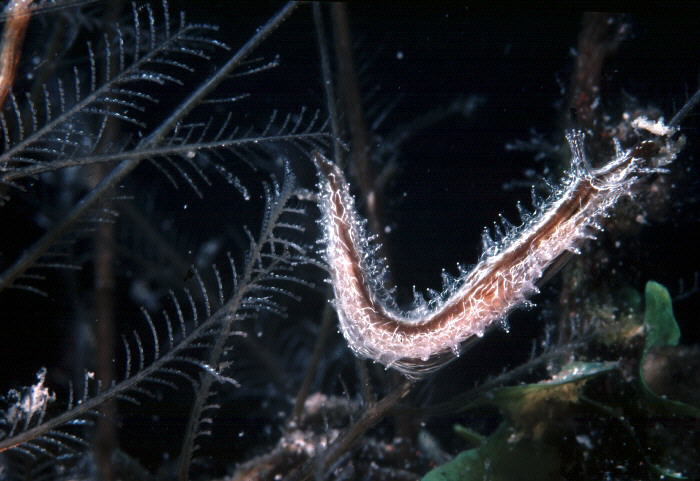 |
Lomanotus vermiformis
Punta Chivato, Baja Californa
Oct. 1984
Lomanotus vermiformis Eliot, 1908
Since I first found this species hidden on its hydroid prey south of Loreto, Baja California Sur, México, it has been one of my favorite species. It has an interesting history, with often overlooked references.
Let me start with some of the nomenclatural meanderings of this species and then continue to aspects of its morphology, zoogeography, natural history, etc.
In 1908, Charles Norton Edgecombe Eliot published an article on some nudibranch from thre Sudanese Red Sea, in which he named Lomanotus vermiformis. He described the external morphology and radula of his specimens, but did not provide an illustration.
In 1957 E. Marcus published a description of L. phiops, which may well turn out to be a synonym of L. vermiformis.
In 1976, Kerry Clark and A. Goetzfried published a description of Lomanotus stauberi from the Atlantic coast of Florida.
In 1985, Terrence Gosliner and I published an article on the records and morphology of Lomanotus stauberi from the Panamic Pacific, citing 2 collecting localities on the Gulf and the Pacific coasts of the Baja California peninsula, illustrating the jaws and radula with scanning electron microscopy, and the reproductive system. We also reported that it occurred cryptically on its food source, the hydroid Lytocarpus philippinus (Kirchenpauer, 1872), and illustrated the animal and its egg mass on the hydroid (Fig 3, Gosliner & Bertsch, 1985).
In 1988, Richard Willan synonymized Lomanotus stauberi with the prior Lomanotus vermiformis, based on species from eastern Australia.
Finally, in 1999, Julie G. Marshall and Richard Willan (citing Beesley, et al., 1998), repeated the synonymy, and presented another synonym for its host hydroid (Macrorhynchia philippina). Their statement of the geographic range of the species was a bit inadequate: "Tropical Indo-Pacific Ocean and eastern Florida in the western Atlantic Ocean. Australian distribution: QLD, NT." Unfortunately, they did not clearly state the Red Sea as the type locality, nor did they mention the eastern Pacific localities that Terry Gosliner and I had earlier reported.
At this time, the synonymy now has been established, and one can report that Lomanotus vermiformis Eliot, 1908, occurs in the western Atlantic (Atlantic coasts of Florida), eastern Pacific (on both coasts of the southern Baja California peninsula), eastern Australia, and in the Red Sea. It should be elsewhere!
Living animals are about 15 mm long maximum. The ground color is translucent white; the notum, head and sides of the body are brown. Irregular darker brown lines extend the entire length of the notum. A network of opaque white lines covers much of the oral tentacles, rhinophores, branchial lobes, helping the organism to blend in with its prey hydroid. The white egg mass consists of a convoluted ribbon oriented along the longitudinal axis of the hydroid stem.
The radular formula is 20 x 7-14.0.7-14 in the specimen from Baja
California. There are 6-15 denticles on the outer side and 6-10 denticles
on the inner side of the radular teeth. Scanning electron micrographs of
the entire radula and close-ups of individual teeth
were taken by Dr. Gosliner.
WEBMASTER'S NOTE: See also the discussion Lomanotus vermiformis on Bill Rudman's Sea Slug Forum.
A PERSONAL NOTE ON THE COLLECTING OF THIS ANIMAL AND HABITAT CONSERVATION:
I feel very strongly about conservation issues, endangered species, lack of knowledge, and habitat destruction both locally and worldwide. I am actively involved in a number of local and international conservation efforts, and know that most readers of the SlugSite are also.
I think it is appropriate to bring to your attention where we first caught these specimens of Lomanotus vermiformis in the Gulf of California and what so called "enterpreneurs" have done to the site.
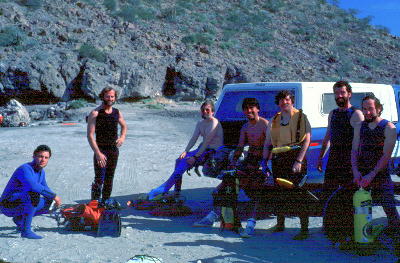
|
As discussed in Terry's and my 1985 article, the specimens were collected from Nopolo, south of Loreto, Baja California Sur, México. The dive team consisted of (from left to right) Hans Hermann (Mexican citizen, and son of a German U-boat commander), Hans Bertsch, Michael Ghiselin, Luis Aguilar (algologist from the Instituto de Investigaciones Oceanológicas de la Universidad Autónoma de Baja California, Ensenada), Terrence Gosliner (carrying an extra air supply for Michael, whom I had taught to scuba dive...), Robert van Syoc, and David Catania (ichthyologist). |
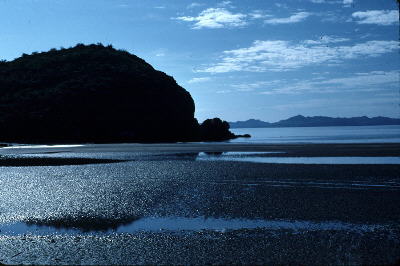
|
The dive site was a beautiful, flat marshy area, between two hills, which quickly dropped into divable conditions once one slogged through the low-tide-exposed mud and dropped into the water. |
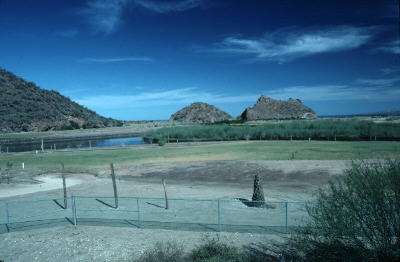
|
Today, this region is a damned golf course. Yes! What had once been a pristine natural estuary, leading into a mangrove swamp, has now been drained and artifically supported by an incredible influx of water into a golf course. It is like growing wheat in a tropical rain forest. In one of the most desertic regions of the Baja California peninsula, certain governmental tourism agencies have created a rich-folks hotel with a golf course!! What ecological arrogance-- the amount of water wasted for greens, when the desert and the people up in the ranches could survive on the little water available.
|
Anyway, I would hope that all of you become more conscious of the need to
protect and preserve as well as to understand the marvelous nudibranch and
marine diversity in our oceans, and support diving, hotel and natural parks
or reserves that conserve and do not destruct.
Imperial Beach
Sept. 2000
Clark, K., and A. Goetzfried. 1976. Lomantous stauberi, a new dendronotacean nudibranch from central Florida (Mollusca: Opisthobranchia). Bull. Mar. Sci. 26 (4): 474-478.
Eliot, C. 1908. Notes on a collection of nudibranchs from the Red Sea. J. Linn. Soc. Lond. (Zool.) 31:86-122
Gosliner, Terrence M., and Hans Bertsch. 1985. Records and morphology of Lomanotus stauberi Clark & Goetzfried, 1976, from the Panamic Pacific. The Veliger 27 (4): 397-405.
Marcus, E. 1957. On Opisthobranchia from Brazil. J. Linn. Soc. Lond. (Zool.) 43 (292): 390- 486.
Marshall, Julie G., and Richard C. Willan. 1999. Nudibranchs of Heron Island, Great Barrier Reef: a survey of the Opisthobranchia (sea slugs) of Heron and Wistari Reefs. Backhuys Publishers Leiden, Netherlands. x + 257 pp.
Willan, R.C. 1988. The taxonomy of two host-specific, cryptic dendronotoid nudibranch species (Mollusca: Gastropoda) from Australia including a new species description. Zool. Jour. Linnean Soc. (1988) 94- 39-63.
Taxnomic Information and Photos courtesy of Dr. Hans Bertsch
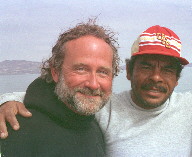
192 Imperial Beach Blvd. #A |
